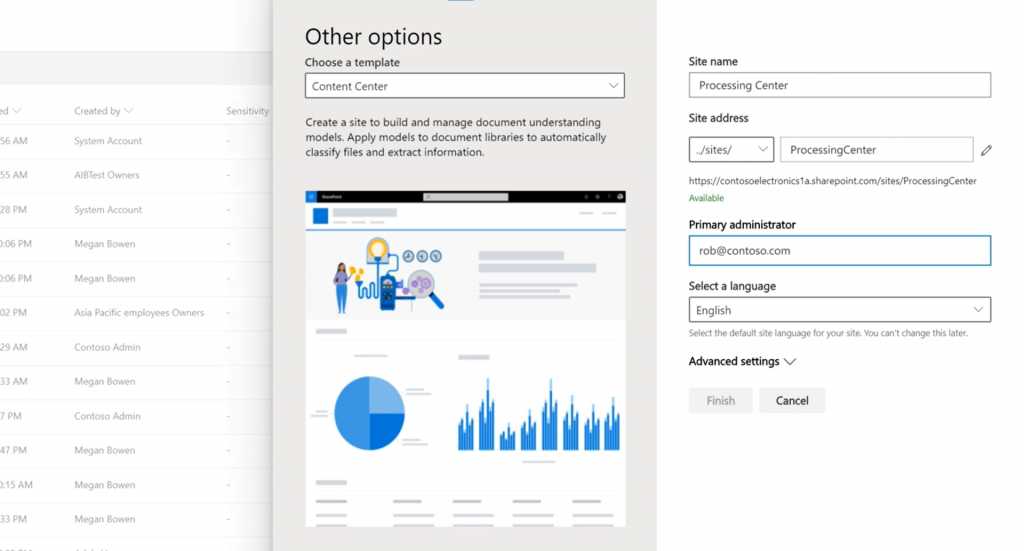Microsoft SharePoint Syntex, the first product to come out of Microsoft’s larger Project Cortex, is now available under general release. But what is it, how does it work, and how much does it cost?
Syntex takes advantge of the advanced AI and machine learning coming out of Project Cortex to automatically categorise and classify documents based on models set up by the user. Using these models, Syntex can extract specific data and apply it as metadata to documents, as well as applying Sensitivity and Retention labels for information protection.
SharePoint Syntex lets users create two types of model: Form Processing and Document Understanding. The difference between the two is that Form Processing extracts values from a structured form, while Document Understanding is trained to pick out information from an unstructured document.
Document Understanding with Syntex
To implement a Document Understanding model, a you first need to provision a Content Center. A Content Center is a SharePoint site that’s used to create and store the different document models, as well as to apply those models to your Document Libraries.

When you have identified a document type you wish to model – such as Statements of Work, CVs/resumés or Purchase Orders – you can create the new model in the Content Center. On creation, the default action is to create a new Content Type; however, you can change this to use an existing Content Type if you have one already set up in your Content Type Hub.
Training a Syntex model
After creating the model, you need to train it by adding in some example files. Syntex only requires five positive examples and one negative example, but more is always better if possible. Once the example files have been uploaded, explanations need to be created alongside them to train the model. The model can then be tested within the Content Center.
You can optionally create Extractors. Extractors provide the ability to draw specific information out of a document – such as a key date, a client name, or a contract value. The information an extractor can pull out of a document can then be mapped to a metadata field on the document.
The final part of a Document Understanding model is the ability to apply a Sensitivity and/or Retention label to the type of document. This ensures that the different document types that are being processed by Syntex can conform to organisational or regulatory requirements for being retained due to the nature of their data, as well as being marked for sensitivity.
Form Processing with Syntex
If your organisation stores documents that are structured forms – such as Purchase Orders – specific key/value pairs from these forms can be extracted and used to populate metadata fields for your documents. Setting this type of model up is done at the Document Library level using Power Automate’s AI Builder functionality.
As with Document Understanding models, you must upload sample documents in order to train the model. Once analysed, it’s simply a case of selecting the fields to be extracted, and ensuring they have been given a suitable name.
SharePoint Syntex pricing
At launch, Microsoft has priecd Syntex at an additional cost of $5 per user per month, so it’s worth taking the time to explore and understand the functionality with a small number of licences before committing to anything larger scale.
The automated categorising and tagging of documents can become very powerful when coupled with other tools within Microsot 365, such as Power Automate or Power BI, but the value of these tools can only come with engaging with different areas of your business to identify the use cases.
Syntex administration and governance
The administration and governance of the functionality will also need to be considered before rolling out at scale. Document Understanding models are added to SharePoint Document Libraries from the Content Center; however, they can only be applied to libraries the acting user can access, so there is the option to devolve the running of this to specified users within your business units. There is also the option to provision more than one Content Center for further separation if this is required.
Every organisation will have its own requirements when coming to implement the functionality made available by SharePoint Syntex. Taking the time to consider how it will be used at the start of the journey will most likely help save some headaches further down the road.
If you’d like to find out more about Microsoft SharePoint Syntex, or any other aspect of Microsoft 365 – such as Teams, sensitivity and retention labelling, information protection – drop us a line below. Our team are subject matter experts in Microsoft 365, and we’re are always happy to see whether we can help you get more done.
Get in touch with our friendly team now:

The CompanyNet team has more than 20 years’ experience of creating Microsoft digital workplaces that really work.
We’re a tight-knit team that delivers results for customers including Scottish Water, Mencap, the Student Loans Company, Walt Disney, Tesco Bank, the Scottish Housing Regulator and many more.
We’re always keen to discuss whether we can help you get more out of Office 365.
